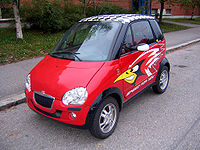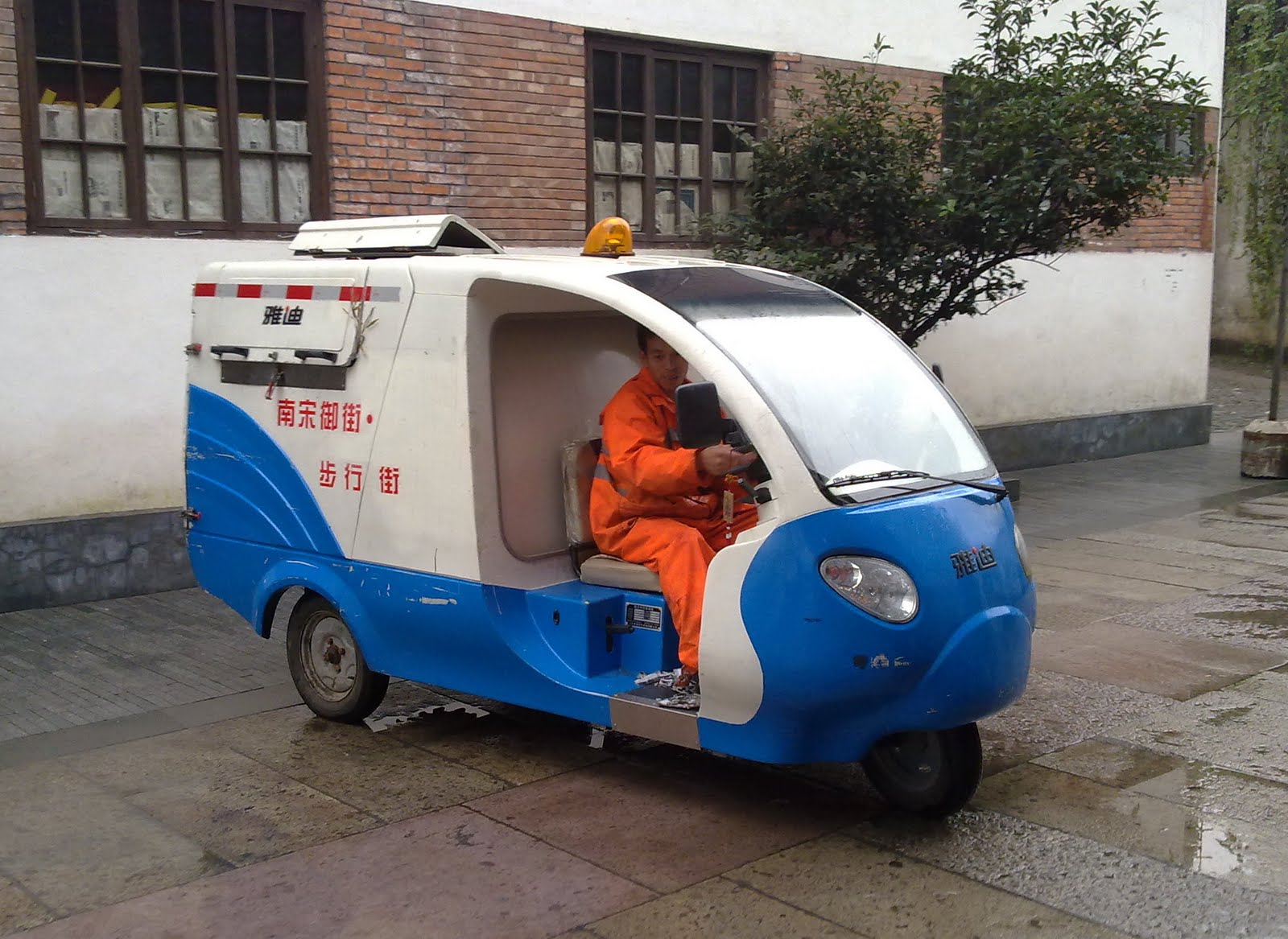- Details
- Category: Motorcycle History

These vehicles typicall have four wheels, unladen mass not more than 350 kg, not including the mass of the batteries. Maximum design speed is not more than 45 km/h and maximum continuous rated power does not exceed 4 kW.
Heavy quadricycles have four wheels, unladen mass is not more than 400 kg or 550 kg for vehicles intended for carrying goods, not including the mass of batteries. The design payload not more than 200 kg (passenger) or 1000 kg (goods) and maximum net engine power does not exceed 15 kW.
With two classes of vehicles most modern transportation needs are met for individuals and small businesses.
- Details
- Category: Motorcycle History
European Union Categories of land vehicles for regulatory purposes.
| § | Category | Description |
|---|---|---|
| 2.1 | L | Motor vehicles with less than four wheels |
| 2.1.1 | L1 | A two-wheeled vehicle with an engine cylinder capacity in the case of a thermic engine not exceeding 50 cm³ and whatever the means of propulsion a maximum design speed not exceeding 50 km/h. |
| 2.1.2 | L2 | A three-wheeled vehicle of any wheel arrangement with an engine cylinder capacity in the case of a thermic engine not exceeding 50 cm³ and whatever the means of propulsion a maximum design speed not exceeding 50 km/h. |
| 2.1.3 | L3 | A two-wheeled vehicle with an engine cylinder capacity in the case of a thermic engine exceeding 50 cm³ or whatever the means of propulsion a maximum design speed exceeding 50 km/h. |
| 2.1.4 | L4 | A vehicle with three wheels asymmetrically arranged in relation to the longitudinal median plane with an engine cylinder capacity in the case of a thermic engine exceeding 50 cm³ or whatever the means of propulsion a maximum design speed exceeding 50 km/h (motor cycles with sidecars). |
| 2.1.5 | L5 | A vehicle with three wheels symmetrically arranged in relation to the longitudinal median plane with an engine cylinder capacity in the case of a thermic engine exceeding 50 cm³ or whatever the means of propulsion a maximum design speed exceeding 50 km/h. |
| 2.1.6 | L6 | A vehicle with four wheels whose unladen mass is not more than 350 kg, not including the mass of the batteries in case of electric vehicles, whose maximum design speed is not more than 45 km/h, and whose engine cylinder capacity does not exceed 50 cm³ for spark (positive) ignition engines, or whose maximum net power output does not exceed 4 kW in the case of other internal combustion engines, or whose maximum continuous rated power does not exceed 4 kW in the case of electric engines. |
| 2.1.7 | L7 | A vehicle with four wheels, other than that classified for the category L6, whose unladen mass is not more than 400 kg (550 kg for vehicles intended for carrying goods), not including the mass of batteries in the case of electric vehicles and whose maximum continuous rated power does not exceed 15 kW. |
| 2.2 | M | Power-driven vehicles having at least four wheels and used for the carriage of passengers |
| 2.2.1 | M1 | Vehicles used for the carriage of passengers and comprising not more than eight seats in addition to the driver's seat. (Passenger car) |
| 2.2.2 | M2 | Vehicles used for the carriage of passengers, comprising more than eight seats in addition to the driver's seat, and having a maximum mass not exceeding 5 tons. (Bus) |
| 2.2.3 | M3 | Vehicles used for the carriage of passengers, comprising more than eight seats in addition to the driver's seat, and having a maximum mass exceeding 5 tons. (Bus) |
| 2.3 | N | Power-driven vehicles having at least four wheels and used for the carriage of goods |
| 2.3.1 | N1 | Vehicles used for the carriage of goods and having a maximum mass not exceeding 3.5 tons. (Pick-up Truck) |
| 2.3.2 | N2 | Vehicles used for the carriage of goods and having a maximum mass exceeding 3.5 tons but not exceeding 12 tons. (Commercial Truck) |
| 2.3.3 | N3 | Vehicles used for the carriage of goods and having a maximum mass exceeding 12 tons. (Commercial Truck) |
| 2.4 | O | >Trailers (including semi–trailers) |
| 2.4.1 | O1 | >Trailers with a maximum mass not exceeding 0.75 tons. |
| 2.4.2 | O2 | >Trailers with a maximum mass exceeding 0.75 tons, but not exceeding 3.5 tons. |
| 2.4.3 | O3 | >Trailers with a maximum mass exceeding 3.5 tons, but not exceeding 10 tons. |
| 2.4.4 | O4 | >Trailers with a maximum mass exceeding 10 tons. |
| 2.5 | Special purpose vehicle | |
| 2.5.1 | Motor caravan, also Campervan, Motorhome | |
| 2.5.2 | Armored car (VIP), Armored car (valuables) | |
| 2.5.3 | Ambulance | |
| 2.5.4 | Hearse | |
| 2.6 | T | Agricultural and Forestry tractors |
| 2.7 | Non-road mobile machinery | |
| 2.8 | G | Off-road vehicles |
| 2.9.2 | Special purpose vehicles (M1) | |
| 2.9.2.1 | SA | Motor caravan: see paragraph 2.5.1. |
| 2.9.2.2 | SA | Armoured vehicle: see paragraph 2.5.2. |
| 2.9.2.3 | SA | Ambulance: see paragraph 2.5.3. |
| 2.9.2.4 | SA | >Hearse: see paragraph 2.5.4. |
- Details
- Category: Motorcycle History
Motorized Cycles are becoming common in many countries. In those countries they are the least expensive and most widespread forms of motorized transport. It is also a means of reducing the effects of urban congestion and pollution.While the reasons for people choosing to ride smaller vehicles like these are many and varied, those reasons are increasingly practical.
Motorized tricycles are a quick way to travel through traffic and conserve energy.
Styles vary depending on the task for which they are designed. As can be seen from the streamlined appearance of new three wheelers there is aerodynamic technology included in the design. Modern fairings and enclosed compartments on vehicles dramatically improve a rider's comfort and attention on long rides by reducing the effect of the wind and rain on the body. Some even are designed as trucks or taxis. Others are multi passenger. Many are fitted with tilting wheels as in the picture above.
Almost all cycles are driven by conventional gasoline internal combustion engines. Some small scooter-type models use an electric motor and a very small number of diesel models exist. Liquid-cooled ones have a radiator giving them the potential for greater power and longer operating life. Air cooled engines are cheaper to purchase, less complex and lighter weight. 
Only a few models are fitted with a reverse gear, usually just the larger ones. At one time, they all used spoke wheels built up from separate components, but one-piece wheels are more common now. Brakes can either be drum or disc based. Disc brakes being more common due to their superior stopping power, particularly in wet conditions.

>Above is a sedan used in Asia, Right is a Chinese delivery version. Pictured at the top is a Peugeot modern version.

